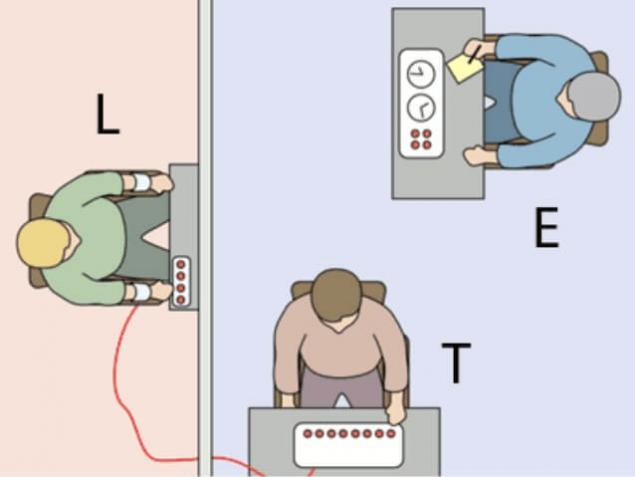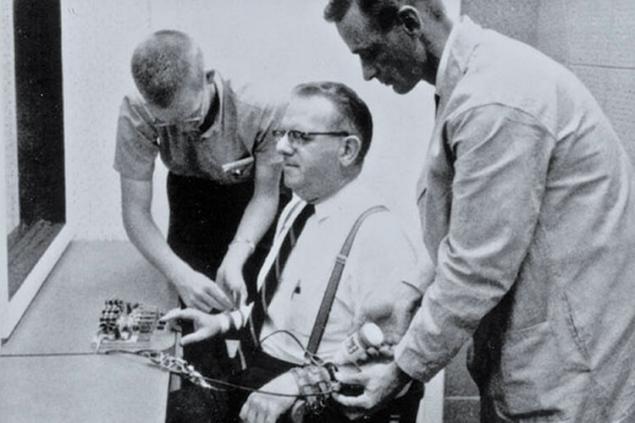716
Stanley Milgram: what is the measure of "obedience" inherent in man
For the first time one of the greatest experiments in the history of psychological science was described by Stanley Milgram in 1963, in the article "Discipline: the study of behavior". In General terms, it is known to many students and, as a rule, willing to comment on the teachers of social Sciences in the context of methodological problems of social research, ethical issues or when we are talking about the subordination of people to public pressure.
The study was the result of reflection Milgram why people are able to act violently towards others, why can the atrocities and crimes against humanity. He came to the conclusion that the ability of subordination — defines the deep tendency of human behavior, its effect can negate the ability to act in accordance with moral norms and to neutralize the sympathy for other people.
In his experiment, Milgram aimed to find out: what is the measure of "obedience" is inherent in man, when it is influenced by the authorities and ordered to act contrary to their own moral principles, how much suffering ready to cause some people to others, completely innocent, when such actions relate to their duties, and the extent to which subordination is usually inclined people under pressure from the authorities.

Talent Milgram as an experimenter lay in the fact that he was able to create an appropriate scientific approach to the study of such a complex social behavior. In the lab, he forced one person to harm another, but really no harm was caused.
Milgram has also created a laboratory model of a situation in which quite accurately have been involved factors, hypothetically, as did the researcher influencing the manifestation of authority.
The participant had to perform the study the role of an assistant of the experimenter, who gave orders that contravene the basic moral values of man. Studied could fulfill the command of the experimenter, or to refuse to do it.
The major theoretical position formulated by Milgrom: human nature and the tendency to subordinate their behavior to another person it perceives itself, authoritative, in addition, under this trend, people may violate moral norms. Milgram believed that the action tendency to subordination to the authoritative person causes a person to hurt another person (which he never did), if they receive an order from someone who considers authority.
In the experiment, conditions were created to determine the extent of subordination of one person to another.
Milgram designed a generator of electric current quite horrible with thirty levers-switches. Each lever was labelled (from 30 to 450 volts) and the switch — reading "mild electric shock", "shock the middle power", "dangerous: powerful blow".
Participants in the experiment were 40 men aged 20 to 50 years, among them, 15 people (both skilled and unskilled), 16 merchants and businessmen, 9 specialists of various professions. They were all invited to participate in a paid study through an ad in the newspaper or in the mail (for research Selskogo University on the problem of memory and learning). For participation in the experiment each paid 4.5 dollars. Participants were informed that they would receive payment regardless of what will be their behavior in the experiment. The study also involved the actors. One of them played the role of experimenter was dressed in a grey lab coat and looked quite official. Another actor played the role of a test subject, he was 47 years old. Both actors were in cahoots with the experimenter.
So, this party, when he fell into the lab of social interaction, reported, "legend":
he is involved in the study of the influence of punishment on the learning process. Then he and the party-the actor has provided the opportunity for the draw to determine their role in the study ("student" or "teacher"). Of course, the real studied always became the "teacher", and "stool pigeon" — "disciple". "Student" in another room strapped to a chair and connected to electrodes attached to the current generator in the next room. While explaining that there is a special paste that conducts electric current and allows to avoid burns and blisters on the skin. All actions carried out on the eyes of the author.
The hands of the student was recorded so that he could get up to four buttons labeled as abed, answering the question "teacher."
The "teacher" should read a list of words and check how they remembered "the apprentice." The experimenter gave the "teacher" instructions: it needs to punish the "learner" every time he would say the wrong thing, adding each incorrect answer one voltage level on the generator. The experiment was so significantly organized that participants could not guess that any "punishment" in fact no one gets.

The scheme of location of the participants. From left to right: "student", "teacher", the experimenter
Answers "student" (a decoy) was planned in advance with alternation of right and wrong in the same sequence to all subjects. With increase in incorrect answers voltage increased, the learner began to shout that he is bad (the phrase was recorded the day before) and complained about pain in the heart. When the voltage reached 300 volts, the learner began kicking the wall and demanded to release him, then he fell silent and never answered the questions. The "teacher" explained that silence is evaluated as a wrong answer and have to act according to the instructions. The majority of participants at some stage has asked the experimenter whether to continue, further increasing tension. The researcher was ordered to continue, gave a series of commands, showing increasing severity, forcing if necessary to act energetically.
The degree of subordination was considered to be the voltage level at which the participant refused to continue the experiment. Since the generator had 30 switches, each analyzed could receive from 1 to 30 points. Participants who reached the highest voltage level, considered "humble" (obedient). Those who refused to obey the commands of the experimenter on the lower voltage levels, — the "rebellious" (defiant).
Researched watched the suffering of "innocent victims", understand the real danger to the life of a "disciple", but the vast majority of participants comply with the orders of the researcher and did not dare to stop the experiment.

Photos from the experiment (1963)
Milgram asked his colleagues as well as alumni of Yale University who majored in psychology, to predict the possible results. Their scores had values from 1 to 3%, the average value is 1.2%. And psychologists beginners and professionals with experience believed that those who inflict the maximum impact, can not be more than 3%.
39 psychiatrists approached by Milgram, gave a less accurate prediction. They believed that only one person out of thousands will increase the voltage to the limit value, and to half, i.e. to 225 volts, not more than half of the subjects. Therefore, none of the psychologists could not have foreseen the results that were obtained. In the real experiment, the majority of the studied obeyed the orders of the experimenter and punishing the learner even after he had stopped screaming and beating the wall with his feet.
The results of the experiment S. Milgram
The impact force (in volts), which caused the participantsNumber of subjects,
who refused to raise the voltage
The weak electric shock
15
30
45
60
0
0
0
0
Medium electric shock
75
90
105
120
0
0
0
0
A strong electric shock
135
150
165
180
0
0
0
0
A very strong electric shock
195
210
225
240
0
0
0
0
Intense blow
255
270
285
300
0
0
0
5
Extreme intense blow
315
330
345
360
4
2
1
1
Dangerous: powerful blow
375
390
405
420
1
0
0
0
The strongest blow
435
450
0
26
Commands of the experimenter, all the studied increased the penalties and reached the level of 300 volts (when the learner gets in the wall, begged to let him go, and then he fell silent and gave no answer). Of course, the most unexpected and shocking was the fact that much of the research was the full scale to the maximum. Only 14 participants refused to follow orders. 26 investigated (65%) completed the experiment at the level of 450 volts. They were in a state of severe stress, worried about the human condition, showed hostility to the experimenters, but still obeyed. In the last part of the experiment, when the learner fell silent, the test was extremely excited. To remove this state of discomfort, to alleviate the condition of study participants, their after the experiment informed about all the intricacies, the overall design of the study and their role. Participants were asked about their thoughts and feelings during the experiment, also there are "student" friendly and put up with each subject.
The experiment showed that the subjects did not resist the "main" researcher, who was dressed in a white robe and demanded to cause suffering to another participant. Overall, the research demonstrated this property of behavior as subordination to the authority, and its deep rootedness in human nature. The participants carried out the orders of the experimenter, although experienced a moral discomfort and internal conflict.
The experiment was repeated in a series of 21 personally Milgrom.
The fact that about two-thirds of the investigated caused to the victim of electric shocks, produced a strong impression on all those involved in the conduct of the study. In the interpretation of the results were formulated as hypothetical interpretations.
1. Participants were influenced by the authority of Yale University.
2. They were men, therefore, showed peculiar to this floor a tendency to aggressive actions.
3. The subjects were not aware of the harm and pain that cause electric shocks.
4. Participants were inclined to sadism, so was pleased to cause suffering to others.
Milgram carefully tested these hypotheses in additional studies and have found that all these explanations do not correspond to the real situation.
Additional experiments
1. Milgram conducted a study outside the walls of Yale University, taking a very shabby room in Bridgeport (Connecticut), decorated with the sign "Research Association of Bridgeport". The researcher did not refer to the Yale University. Research Association of Bridgeport was presented as a commercial organization. The findings in these experimental conditions was fairly close to the main study: go through the whole scale of penalties agreed 48% of the subjects.
2. In another research series Milgram showed that women"teachers" behaved as well as men in the first experiment. The results showed that the fairer sex was more heartfelt and compassionate.
3. In order to determine the participants aware of physical harm and the degree of pain experienced by the victim before the start of the study were introduced a detail: the "learner" said that he had heart trouble and he will not be able to withstand the pain from the electric shocks. In the study, the "learner" complained of pain in the heart, begged me to stop the process. However, such changes did not introduce any corrections into the results: 65% of "teachers" performed their duties and brought the voltage up to max.
4. As a result of further study, it was proven that the hypothesis about the specific mental disorder of the participants had no reason to. All participants who responded to the ad Milgram invitation to participate in the study of the effect of punishment on memory for their data, educational levels, occupations were ordinary people, their answers to questions of special tests personal characteristics showed that this is quite normal and balanced person. Describing his subjects, Milgram said that they were quite ordinary people, for which we can say that "they have us with you."
5. In a situation when the experimenter came out and left his "assistant", only 20% of the participants agreed to continue the experiment. Therefore, it cannot be assumed that experimental opportunity to punish the "victim" brought the study pleasure. When the participants themselves had the opportunity to determine the punishment, 95% stayed in the range of 150 volts.
So, again, all proposed hypotheses were refuted.
The scientist also studied the effect of the distance between the reputable entity and is researched on the level of subordination. When the experimenter was outside the room and gave the studied team on the phone, the level of obedience dropped to 21%.
A special variant was the situation when subjects were allowed at their discretion to choose the appropriate level of punishment — none of the participants did not put a switch above 45 volts.
Milgram beginning of the study, wanted to find out why German citizens had participated in the destruction of millions of innocent people in concentration camps. He wanted to conduct an experiment in Germany, when it is determined with the methodology of the study. He believed that the people of this country have been more inclined to obedience (subordination). However, after conducting the first experiment, he said: "I found so much obedience here that don't see the need to conduct this experiment in Germany".
Thomas Blass, a researcher from the University of Maryland in 2002 in the journal Psychology Today has considered the results of all repetitions of the experiment, Milgram, which were conducted in the U.S. and other countries. It was found that the end scale reaches from 60 to 66% of the studied individuals, and data do not depend on time and place of the study.
What makes ordinary people behave in this way?
Milgram explained the results of his study: in the mind of man is deeply ingrained need to obey authority. A decisive role was played by the inability of the subjects to openly confront the "boss" (the researcher), who is ordered to perform tasks, in spite of the pain inflicted on "the apprentice". Milgram said that it is obvious that if the researcher is allowed to stop the experiment, participants were immediately fulfilled. They did not seek to complete tasks, saw the suffering of the victim and was discouraged. They asked the experimenter to stop the study, but when not given permission, then continued to press the button. Studied protested, sweated, asked to free the victim, clutching his head, clenched his fists so that the nails are reflected on the palms, bit my lip, some nervously laughed.
Behind the transparent glass with mirror effect were psychologists, Milgram's colleagues, who watched the course of the experiment. Milgram cites the testimony of one eyewitness: "I saw in the beginning of the lab became a respectable businessman, a smiling and confident. 20 minutes of work with switches voltage he already looked completely different, a loser, that was grumbling, was on the verge of a nervous breakdown... He was shaking, stuttering, constantly pulled his earlobe and wringing his hands. At some point, grabbed his head and whispered: "Oh my God! Stop it!". Nevertheless, he continued to respond to every word of the experimenter and perfectly listened (obeyed) to the end of the experiment".
In a 1965 study by S. Milgram was awarded the annual sociopsychological prize of the American Association for the advancement of science.
The data obtained was given a lot of explanations:
The cause of the behavior is significant regulatory pressure. The experimenter is making a considerable pressure, forcing studied to fulfill his orders. The trend towards shared responsibility: responsible behavior in a crisis or ambiguous situations participants tend to think of others. Conflict of social norms. When the subject first hit the victim, he forces himself to the execution of the order, has on the pressure.
Milgram in his experiment noted such significant moments.
First of all, an extremely strong tendency to obedience. The study involved ordinary people, not prone to cruelty. Milgram pointed out that people behaved so meekly, breaking acquired in childhood norms, what is not to hurt another person because he was under the influence of the authority of the experimenter. However, we must determine what was the authority, because the experimenter did not make particularly serious pressure on subjects who did not use any special action to force the parties to obey. They were completely free to ignore all the requests and orders, to act on their own they were never banned. The main power of coercion was the situation itself, which has launched habitual behavior.
Participants in the study, fulfilling the command of the experimenter, was in great excitement and tension. Because the discomfort and the excitement was quite strong and noticeable when observing, there were expectations that in the end the researched will refuse to execute commands.
Milgram himself has identified the following reasons for obedience — from the point of view of the subjects:
The experiment carried out at Yale University, working professionals and I have no right to doubt in such an important institution. The experiment aimed at the achievement of an important task, and when I have already agreed to participate in it, it needs to perform its task. I have committed to participate in the study, therefore, should perform them. Circumstances have developed in such a way that I am "the teacher" and he the "student". So fell, it was an accident. Next time might be different. I pay for the work, so you need to implement it properly. I don't know all the rules in the behavior of psychologists and studied, so I have to agree with their point of view. The researchers told both of us that the electric current is not painful and safe.
The Milgram experiment, perhaps, recent psychological experiment, which so significantly influenced the psychology and public opinion. It's been more than 30 years, but it still is of interest and produces a great impression on those who met him for the first time.
Criticism of the experiment
Milgram quite serious problem of ethical norms in conducting research with humans. Critics of this experiment have made your position quite strongly, noting that such research is invalid because it was created for participants to unacceptable levels of stress (D. Baumrind, 1964, Miller, 1986). It is also said that the study may have for its participants long-term consequences, after all, learning about the true purpose and consequences of the experiment, they can be executed distrust of psychologists or other persons in authority.
Psychologists have also expressed doubts about the validity of Milgram's findings. Researched came to the lab, they take a commitment and felt dependent on the experimenter. In addition, the laboratory for them — this is an unusual situation, so their subordination and obedience in this situation will not be the same as in real life.
Therefore, the results of the research were evaluated as unfounded, absolutely not comparable to real human behavior, but a measure of dangerous stress for the subjects — as excessive and unjustified.
Defending the work of Milgram have conducted additional research to explore the reaction of participants. 85% were happy that I worked with a psychologist, and only 1% took part in the experiment were sorry. All 40 participants were also examined by a psychiatrist who gave the opinion that no one was hurt and has no reason to expect any negative long-term effects in the future.
Milgram replied to his critics: "People who came to the lab to participate in the experiment, only adult, active, able to accept or reject the recommended action."
Experiment Milgram actively discussed and evaluated by psychologists. The controversy revolved around two issues: how to respond to the real human behavior the findings of the study and what principles are important to consider in psychological research in General. American psychologist Blas, a young colleague of Milgram conducted a thorough review of all the studies that have examined the problems of command and associated with early experiments Milgram. Blas said the conclusions Milgram fair, also generic, similar experiments conducted by other researchers for 40 years, indicate that the level of subordination has not since changed. This conclusion does not confirm the expectations of psychologists and democratic public institutions that modern people are not so subservient to authority and can act independently and protest, not agreeing to carry out the orders of the authorities. In particular, in his review of Blas the results of the research found that there is no difference between the obedience of men and women.
An important issue in discussions around the research of Milgram, which again and again attracts researchers ' attention is whether it is possible to avoid deception, which is so often and readily practiced by the researchers. Why psychologists are so easy to choose cheating as they are truthful, arguing that doing it for the sake of science, why don't they choose for themselves are really more ethical strategy? How to protect people from the irresponsible practices of deception researchers, because the openness of the research, as a rule, leads to the impossibility of obtaining the really important data.
Individual psychologists believe that at least should inform participants that they will not be able to know the whole truth about the study, and let them then make the decision if they agree to participate on such terms and conditions ("agreement with skill") (D. Wendler, 1996). Of course, psychologists should take a more thoughtful approach to the fact that in studies without a serious need practiced deception as disrespect to members is not justified. Psychologists need to search for such an experimental strategy that would ensure them respect for study participants and quality of scientific results.
In conclusion, we note that, in our opinion, the studies of Milgram is not universal, according to Blas. Finally it is proved that the pressure of the situation forces to submit to, and personal factors do not apply. In the experiment Milgram 14 investigated did not obey the experimenter. Blas and myself have indicated that personal factors (traits, beliefs) are more decisive than the tendency to obey authority.published
P. S. And remember, just changing your mind — together we change the world! ©
Join us in Facebook , Vkontakte, Odnoklassniki
Source: psychojournal.ru/article/724-eksperiment-stenli-milgrama-podchinenie-avtoritetu.html
The study was the result of reflection Milgram why people are able to act violently towards others, why can the atrocities and crimes against humanity. He came to the conclusion that the ability of subordination — defines the deep tendency of human behavior, its effect can negate the ability to act in accordance with moral norms and to neutralize the sympathy for other people.
In his experiment, Milgram aimed to find out: what is the measure of "obedience" is inherent in man, when it is influenced by the authorities and ordered to act contrary to their own moral principles, how much suffering ready to cause some people to others, completely innocent, when such actions relate to their duties, and the extent to which subordination is usually inclined people under pressure from the authorities.

Talent Milgram as an experimenter lay in the fact that he was able to create an appropriate scientific approach to the study of such a complex social behavior. In the lab, he forced one person to harm another, but really no harm was caused.
Milgram has also created a laboratory model of a situation in which quite accurately have been involved factors, hypothetically, as did the researcher influencing the manifestation of authority.
The participant had to perform the study the role of an assistant of the experimenter, who gave orders that contravene the basic moral values of man. Studied could fulfill the command of the experimenter, or to refuse to do it.
The major theoretical position formulated by Milgrom: human nature and the tendency to subordinate their behavior to another person it perceives itself, authoritative, in addition, under this trend, people may violate moral norms. Milgram believed that the action tendency to subordination to the authoritative person causes a person to hurt another person (which he never did), if they receive an order from someone who considers authority.
In the experiment, conditions were created to determine the extent of subordination of one person to another.
Milgram designed a generator of electric current quite horrible with thirty levers-switches. Each lever was labelled (from 30 to 450 volts) and the switch — reading "mild electric shock", "shock the middle power", "dangerous: powerful blow".
Participants in the experiment were 40 men aged 20 to 50 years, among them, 15 people (both skilled and unskilled), 16 merchants and businessmen, 9 specialists of various professions. They were all invited to participate in a paid study through an ad in the newspaper or in the mail (for research Selskogo University on the problem of memory and learning). For participation in the experiment each paid 4.5 dollars. Participants were informed that they would receive payment regardless of what will be their behavior in the experiment. The study also involved the actors. One of them played the role of experimenter was dressed in a grey lab coat and looked quite official. Another actor played the role of a test subject, he was 47 years old. Both actors were in cahoots with the experimenter.
So, this party, when he fell into the lab of social interaction, reported, "legend":
he is involved in the study of the influence of punishment on the learning process. Then he and the party-the actor has provided the opportunity for the draw to determine their role in the study ("student" or "teacher"). Of course, the real studied always became the "teacher", and "stool pigeon" — "disciple". "Student" in another room strapped to a chair and connected to electrodes attached to the current generator in the next room. While explaining that there is a special paste that conducts electric current and allows to avoid burns and blisters on the skin. All actions carried out on the eyes of the author.
The hands of the student was recorded so that he could get up to four buttons labeled as abed, answering the question "teacher."
The "teacher" should read a list of words and check how they remembered "the apprentice." The experimenter gave the "teacher" instructions: it needs to punish the "learner" every time he would say the wrong thing, adding each incorrect answer one voltage level on the generator. The experiment was so significantly organized that participants could not guess that any "punishment" in fact no one gets.

The scheme of location of the participants. From left to right: "student", "teacher", the experimenter
Answers "student" (a decoy) was planned in advance with alternation of right and wrong in the same sequence to all subjects. With increase in incorrect answers voltage increased, the learner began to shout that he is bad (the phrase was recorded the day before) and complained about pain in the heart. When the voltage reached 300 volts, the learner began kicking the wall and demanded to release him, then he fell silent and never answered the questions. The "teacher" explained that silence is evaluated as a wrong answer and have to act according to the instructions. The majority of participants at some stage has asked the experimenter whether to continue, further increasing tension. The researcher was ordered to continue, gave a series of commands, showing increasing severity, forcing if necessary to act energetically.
The degree of subordination was considered to be the voltage level at which the participant refused to continue the experiment. Since the generator had 30 switches, each analyzed could receive from 1 to 30 points. Participants who reached the highest voltage level, considered "humble" (obedient). Those who refused to obey the commands of the experimenter on the lower voltage levels, — the "rebellious" (defiant).
Researched watched the suffering of "innocent victims", understand the real danger to the life of a "disciple", but the vast majority of participants comply with the orders of the researcher and did not dare to stop the experiment.

Photos from the experiment (1963)
Milgram asked his colleagues as well as alumni of Yale University who majored in psychology, to predict the possible results. Their scores had values from 1 to 3%, the average value is 1.2%. And psychologists beginners and professionals with experience believed that those who inflict the maximum impact, can not be more than 3%.
39 psychiatrists approached by Milgram, gave a less accurate prediction. They believed that only one person out of thousands will increase the voltage to the limit value, and to half, i.e. to 225 volts, not more than half of the subjects. Therefore, none of the psychologists could not have foreseen the results that were obtained. In the real experiment, the majority of the studied obeyed the orders of the experimenter and punishing the learner even after he had stopped screaming and beating the wall with his feet.
The results of the experiment S. Milgram
The impact force (in volts), which caused the participantsNumber of subjects,
who refused to raise the voltage
The weak electric shock
15
30
45
60
0
0
0
0
Medium electric shock
75
90
105
120
0
0
0
0
A strong electric shock
135
150
165
180
0
0
0
0
A very strong electric shock
195
210
225
240
0
0
0
0
Intense blow
255
270
285
300
0
0
0
5
Extreme intense blow
315
330
345
360
4
2
1
1
Dangerous: powerful blow
375
390
405
420
1
0
0
0
The strongest blow
435
450
0
26
Commands of the experimenter, all the studied increased the penalties and reached the level of 300 volts (when the learner gets in the wall, begged to let him go, and then he fell silent and gave no answer). Of course, the most unexpected and shocking was the fact that much of the research was the full scale to the maximum. Only 14 participants refused to follow orders. 26 investigated (65%) completed the experiment at the level of 450 volts. They were in a state of severe stress, worried about the human condition, showed hostility to the experimenters, but still obeyed. In the last part of the experiment, when the learner fell silent, the test was extremely excited. To remove this state of discomfort, to alleviate the condition of study participants, their after the experiment informed about all the intricacies, the overall design of the study and their role. Participants were asked about their thoughts and feelings during the experiment, also there are "student" friendly and put up with each subject.
The experiment showed that the subjects did not resist the "main" researcher, who was dressed in a white robe and demanded to cause suffering to another participant. Overall, the research demonstrated this property of behavior as subordination to the authority, and its deep rootedness in human nature. The participants carried out the orders of the experimenter, although experienced a moral discomfort and internal conflict.
The experiment was repeated in a series of 21 personally Milgrom.
The fact that about two-thirds of the investigated caused to the victim of electric shocks, produced a strong impression on all those involved in the conduct of the study. In the interpretation of the results were formulated as hypothetical interpretations.
1. Participants were influenced by the authority of Yale University.
2. They were men, therefore, showed peculiar to this floor a tendency to aggressive actions.
3. The subjects were not aware of the harm and pain that cause electric shocks.
4. Participants were inclined to sadism, so was pleased to cause suffering to others.
Milgram carefully tested these hypotheses in additional studies and have found that all these explanations do not correspond to the real situation.
Additional experiments
1. Milgram conducted a study outside the walls of Yale University, taking a very shabby room in Bridgeport (Connecticut), decorated with the sign "Research Association of Bridgeport". The researcher did not refer to the Yale University. Research Association of Bridgeport was presented as a commercial organization. The findings in these experimental conditions was fairly close to the main study: go through the whole scale of penalties agreed 48% of the subjects.
2. In another research series Milgram showed that women"teachers" behaved as well as men in the first experiment. The results showed that the fairer sex was more heartfelt and compassionate.
3. In order to determine the participants aware of physical harm and the degree of pain experienced by the victim before the start of the study were introduced a detail: the "learner" said that he had heart trouble and he will not be able to withstand the pain from the electric shocks. In the study, the "learner" complained of pain in the heart, begged me to stop the process. However, such changes did not introduce any corrections into the results: 65% of "teachers" performed their duties and brought the voltage up to max.
4. As a result of further study, it was proven that the hypothesis about the specific mental disorder of the participants had no reason to. All participants who responded to the ad Milgram invitation to participate in the study of the effect of punishment on memory for their data, educational levels, occupations were ordinary people, their answers to questions of special tests personal characteristics showed that this is quite normal and balanced person. Describing his subjects, Milgram said that they were quite ordinary people, for which we can say that "they have us with you."
5. In a situation when the experimenter came out and left his "assistant", only 20% of the participants agreed to continue the experiment. Therefore, it cannot be assumed that experimental opportunity to punish the "victim" brought the study pleasure. When the participants themselves had the opportunity to determine the punishment, 95% stayed in the range of 150 volts.
So, again, all proposed hypotheses were refuted.
- The results of the study did not affect the credibility of the University.
- Gender of the test persons did not affect the results obtained.
- Studied were well aware of the danger of electric shocks to study participants.
- Studied were normal ordinary people and did not have the tendencies of a pathological nature, at least, they certainly weren't sadists.
- When the instructions during the experiment were provided on the phone, "obedience" has become smaller (it was typical for only 20% of participants). In such a situation studied was only pretending to continue the experiment.
- If a participant is caught in a situation with two researchers, one of whom was ordered to stop, and the other insisted on continuing, he refused to continue to participate in the experiment.
The scientist also studied the effect of the distance between the reputable entity and is researched on the level of subordination. When the experimenter was outside the room and gave the studied team on the phone, the level of obedience dropped to 21%.
A special variant was the situation when subjects were allowed at their discretion to choose the appropriate level of punishment — none of the participants did not put a switch above 45 volts.
Milgram beginning of the study, wanted to find out why German citizens had participated in the destruction of millions of innocent people in concentration camps. He wanted to conduct an experiment in Germany, when it is determined with the methodology of the study. He believed that the people of this country have been more inclined to obedience (subordination). However, after conducting the first experiment, he said: "I found so much obedience here that don't see the need to conduct this experiment in Germany".
Thomas Blass, a researcher from the University of Maryland in 2002 in the journal Psychology Today has considered the results of all repetitions of the experiment, Milgram, which were conducted in the U.S. and other countries. It was found that the end scale reaches from 60 to 66% of the studied individuals, and data do not depend on time and place of the study.
What makes ordinary people behave in this way?
Milgram explained the results of his study: in the mind of man is deeply ingrained need to obey authority. A decisive role was played by the inability of the subjects to openly confront the "boss" (the researcher), who is ordered to perform tasks, in spite of the pain inflicted on "the apprentice". Milgram said that it is obvious that if the researcher is allowed to stop the experiment, participants were immediately fulfilled. They did not seek to complete tasks, saw the suffering of the victim and was discouraged. They asked the experimenter to stop the study, but when not given permission, then continued to press the button. Studied protested, sweated, asked to free the victim, clutching his head, clenched his fists so that the nails are reflected on the palms, bit my lip, some nervously laughed.
Behind the transparent glass with mirror effect were psychologists, Milgram's colleagues, who watched the course of the experiment. Milgram cites the testimony of one eyewitness: "I saw in the beginning of the lab became a respectable businessman, a smiling and confident. 20 minutes of work with switches voltage he already looked completely different, a loser, that was grumbling, was on the verge of a nervous breakdown... He was shaking, stuttering, constantly pulled his earlobe and wringing his hands. At some point, grabbed his head and whispered: "Oh my God! Stop it!". Nevertheless, he continued to respond to every word of the experimenter and perfectly listened (obeyed) to the end of the experiment".
In a 1965 study by S. Milgram was awarded the annual sociopsychological prize of the American Association for the advancement of science.
The data obtained was given a lot of explanations:
The cause of the behavior is significant regulatory pressure. The experimenter is making a considerable pressure, forcing studied to fulfill his orders. The trend towards shared responsibility: responsible behavior in a crisis or ambiguous situations participants tend to think of others. Conflict of social norms. When the subject first hit the victim, he forces himself to the execution of the order, has on the pressure.
Milgram in his experiment noted such significant moments.
First of all, an extremely strong tendency to obedience. The study involved ordinary people, not prone to cruelty. Milgram pointed out that people behaved so meekly, breaking acquired in childhood norms, what is not to hurt another person because he was under the influence of the authority of the experimenter. However, we must determine what was the authority, because the experimenter did not make particularly serious pressure on subjects who did not use any special action to force the parties to obey. They were completely free to ignore all the requests and orders, to act on their own they were never banned. The main power of coercion was the situation itself, which has launched habitual behavior.
Participants in the study, fulfilling the command of the experimenter, was in great excitement and tension. Because the discomfort and the excitement was quite strong and noticeable when observing, there were expectations that in the end the researched will refuse to execute commands.
Milgram himself has identified the following reasons for obedience — from the point of view of the subjects:
The experiment carried out at Yale University, working professionals and I have no right to doubt in such an important institution. The experiment aimed at the achievement of an important task, and when I have already agreed to participate in it, it needs to perform its task. I have committed to participate in the study, therefore, should perform them. Circumstances have developed in such a way that I am "the teacher" and he the "student". So fell, it was an accident. Next time might be different. I pay for the work, so you need to implement it properly. I don't know all the rules in the behavior of psychologists and studied, so I have to agree with their point of view. The researchers told both of us that the electric current is not painful and safe.
The Milgram experiment, perhaps, recent psychological experiment, which so significantly influenced the psychology and public opinion. It's been more than 30 years, but it still is of interest and produces a great impression on those who met him for the first time.
Criticism of the experiment
Milgram quite serious problem of ethical norms in conducting research with humans. Critics of this experiment have made your position quite strongly, noting that such research is invalid because it was created for participants to unacceptable levels of stress (D. Baumrind, 1964, Miller, 1986). It is also said that the study may have for its participants long-term consequences, after all, learning about the true purpose and consequences of the experiment, they can be executed distrust of psychologists or other persons in authority.
Psychologists have also expressed doubts about the validity of Milgram's findings. Researched came to the lab, they take a commitment and felt dependent on the experimenter. In addition, the laboratory for them — this is an unusual situation, so their subordination and obedience in this situation will not be the same as in real life.
Therefore, the results of the research were evaluated as unfounded, absolutely not comparable to real human behavior, but a measure of dangerous stress for the subjects — as excessive and unjustified.
Defending the work of Milgram have conducted additional research to explore the reaction of participants. 85% were happy that I worked with a psychologist, and only 1% took part in the experiment were sorry. All 40 participants were also examined by a psychiatrist who gave the opinion that no one was hurt and has no reason to expect any negative long-term effects in the future.
Milgram replied to his critics: "People who came to the lab to participate in the experiment, only adult, active, able to accept or reject the recommended action."
Experiment Milgram actively discussed and evaluated by psychologists. The controversy revolved around two issues: how to respond to the real human behavior the findings of the study and what principles are important to consider in psychological research in General. American psychologist Blas, a young colleague of Milgram conducted a thorough review of all the studies that have examined the problems of command and associated with early experiments Milgram. Blas said the conclusions Milgram fair, also generic, similar experiments conducted by other researchers for 40 years, indicate that the level of subordination has not since changed. This conclusion does not confirm the expectations of psychologists and democratic public institutions that modern people are not so subservient to authority and can act independently and protest, not agreeing to carry out the orders of the authorities. In particular, in his review of Blas the results of the research found that there is no difference between the obedience of men and women.
An important issue in discussions around the research of Milgram, which again and again attracts researchers ' attention is whether it is possible to avoid deception, which is so often and readily practiced by the researchers. Why psychologists are so easy to choose cheating as they are truthful, arguing that doing it for the sake of science, why don't they choose for themselves are really more ethical strategy? How to protect people from the irresponsible practices of deception researchers, because the openness of the research, as a rule, leads to the impossibility of obtaining the really important data.
Individual psychologists believe that at least should inform participants that they will not be able to know the whole truth about the study, and let them then make the decision if they agree to participate on such terms and conditions ("agreement with skill") (D. Wendler, 1996). Of course, psychologists should take a more thoughtful approach to the fact that in studies without a serious need practiced deception as disrespect to members is not justified. Psychologists need to search for such an experimental strategy that would ensure them respect for study participants and quality of scientific results.
In conclusion, we note that, in our opinion, the studies of Milgram is not universal, according to Blas. Finally it is proved that the pressure of the situation forces to submit to, and personal factors do not apply. In the experiment Milgram 14 investigated did not obey the experimenter. Blas and myself have indicated that personal factors (traits, beliefs) are more decisive than the tendency to obey authority.published
P. S. And remember, just changing your mind — together we change the world! ©
Join us in Facebook , Vkontakte, Odnoklassniki
Source: psychojournal.ru/article/724-eksperiment-stenli-milgrama-podchinenie-avtoritetu.html























